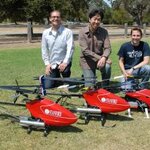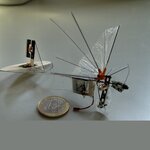Aerospace
The lighter an aircraft is, the less fuel it consumes. Given the need to cut carbon dioxide emissions, this is a key aspect of materials research. Aircraft manufacturers are therefore pinning their hopes on particularly lightweight construction materials. These include not only lightweight metals, but also fiber composite plastics, particularly carbon-fiber reinforced plastics (CFRPs). Whenever two CFRP components have to be joined together, this has so far been accomplished primarily by riveting.
Researchers at the Fraunhofer Institute for Manufacturing Technology and Applied Materials…

Engineers from NASA and Pratt & Whitney Rocketdyne successfully completed a series of hot-fire altitude tests using liquid methane on the RS-18 engine, which was last used to lift astronauts off the moon's surface 36 years ago and was originally flown with storable hypergolic propellants during the Apollo moon missions.
The tests, conducted at White Sands test facility in New Mexico, are part of the technology development for NASA's Constellation program, and gathered important data on ignition, performance measurement, and rapid start and stop.
The RS-18 engine has been modified to…

A new age for air travel is dawning; at least if you’re one of the lucky few in the market for supersonic luxury travel. Lockheed Martin's advanced Skunk Works unit is designing a small, 12-seat passenger jet that would travel at 1,200 mph (Mach 1.8) but which would produce only a whisper of the annoying crack once emitted by the retired Concorde.
Aimed at business executives and diplomats, the QSST will fly at nearly twice the speed of conventional business jets and have a range of 4,600 miles nonstop -- Los Angeles to New York in just over two hours. The sleek, 130-foot-long QSST (for "…

Stanford computer scientists have developed an artificial intelligence system that enables robotic helicopters to teach themselves to fly difficult stunts by watching other helicopters perform the same maneuvers.
The result is an autonomous helicopter than can perform a complete airshow of complex tricks on its own.
The stunts are "by far the most difficult aerobatic maneuvers flown by any computer controlled helicopter," said Andrew Ng, the professor directing the research of graduate students Pieter Abbeel, Adam Coates, Timothy Hunter and Morgan Quigley.
Stanford computer science…

Gravity field and steady-state Ocean Circulation Explorer - GOCE will be launched in a few weeks (10 September 2008). It is one of the biggest event within geodesy this year, hell probably in the history of geodesy. GOCE will improve our knowledge of this planet's gravity so that we eventually can all compare heights based on the same height reference system. And many other cool applications will come out of us knowing our gravity field in more detail also from remote areas such as the Tibetan plateau.
If you are into rocket launching, here is another exciting event to follow directly on the…

This DelFly Micro, made by Delft University of Technology, is a 'Micro Air Vehicle' (MAV), an exceptionally small remote-controlled aircraft with camera and image recognition software. The Micro, weighing just 3 grams and measuring 10 centimeters (wingtip to wingtip) has a minuscule battery weighing just 1 gram, can fly for approximately three minutes and has a maximum speed of 5 meters per second.
This kind of ultra-small, remote-controlled, camera-equipped aircraft is of great interest because they could eventually be used for observation flights in difficult-to-reach or dangerous areas.…

There's a satellite in medium Earth orbit - one of 31 U.S. Air Force satellites - that carries some special cargo; a collection of sensors to detect and triangulate airborne or space-based nuclear explosions anywhere they may occur.
In the recent past, detection has been no problem — there haven’t been any above-ground explosions for decades - but there could be one any time and the country that did it could simply deny if its leaders didn’t believe anyone could track it.
These sensors have to be ready to detect a real explosion and also to compensate for false alarms: There are lightning…

Since earliest recorded history, and presumably beyond, humans have always wanted to fly. First attempts involved imitation of winged creatures around them, and unfailingly ended in disaster.
No workable flying machines have ever looked particularly similar to nature's fliers, and today there is little comparison between a top of the range military chopper and the humble bumblebee, despite similar flight patterns.
In an era in which engineers are increasingly exploiting designs from nature, understanding this paradox is becoming ever more important. Dr Jim Usherwood, from the Royal…

A self-healing aircraft could be available in the near future, thanks to an epoxy resin developed by Bristol University aerospace engineers that ‘bleeds’ from embedded vessels near the holes or cracks and quickly seals them up, restoring structural integrity.
As well as the obvious safety benefits, this breakthrough could make it possible to design lighter aeroplanes in the future. This would lead to fuel savings, cutting costs for airlines and passengers and reducing carbon emissions too.
By mixing dye into the resin, any ‘self-mends’ could be made to show as colored patches that could…

The F-35 is a supersonic, multi-role, 5th generation stealth fighter. Three F-35 variants derived from a common design, developed together and using the same sustainment infrastructure worldwide, will replace at least 13 types of aircraft for 11 nations initially, making the Lightning II the most economical fighter program in history.
The program is on schedule to deliver aircraft to the U.S. military services beginning in 2010. The first test aircraft has completed 35 flights and has exceeded performance expectations. The inaugural flight of the first short takeoff/vertical landing F-35B…